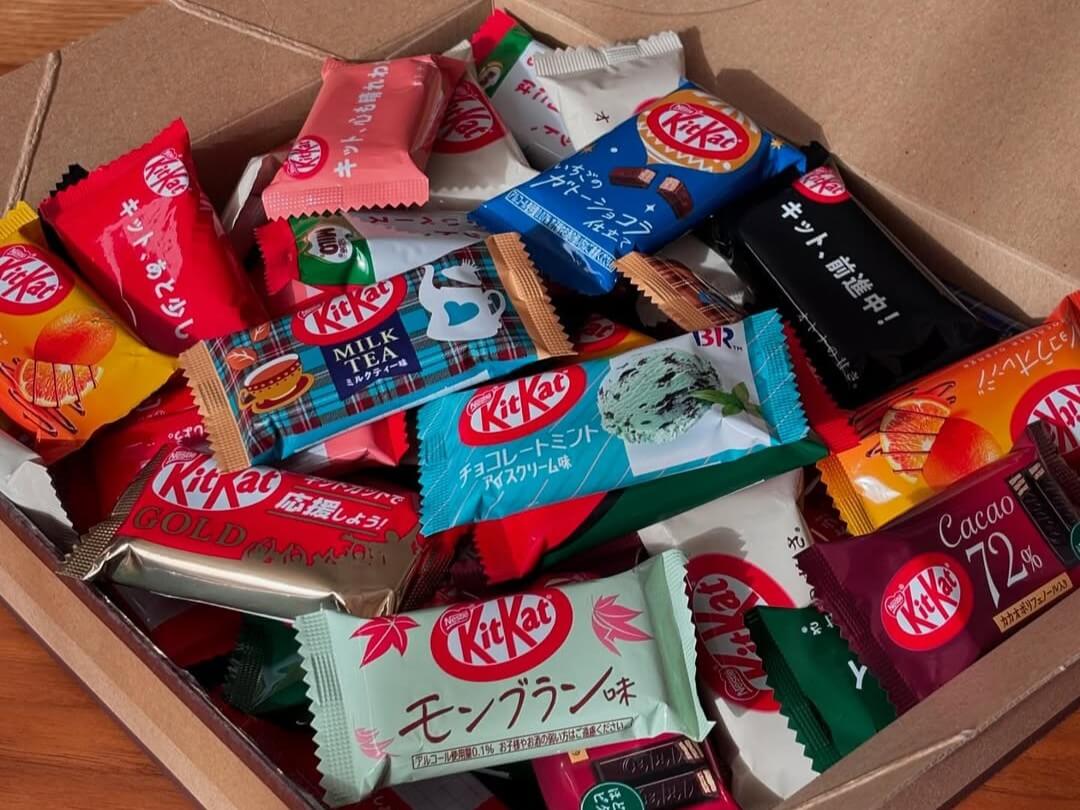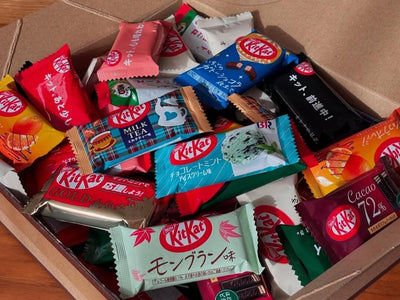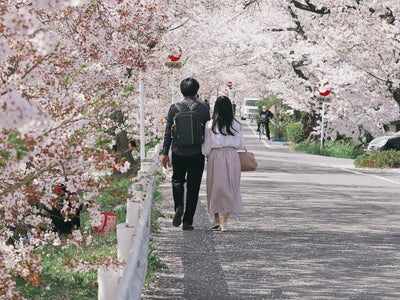When it comes to the world of Japanese chocolate, we enjoy tons of amazing and high-quality options here. From regional favorites like Hokkaido chocolate to everyday treats from big brands like Meiji. However, no chocolate treat has spread from here to the rest of the world like the Japanese Kit Kat!
That’s why we’re taking a dive into the world of Japanese Kit Kats, including what makes them special, some of their amazing flavors and a bit of its cultural relevance!
How & When Kit Kat Came to Japan?
The Kit Kat brand originally came from the UK way back in 1935 (as we know it now), but dates back to 1911 when it was just a boxed chocolate. It actually got its current shape from a suggestion from a worker in the Rowntree York Factory from a suggestion box!
Kit Kat eventually came to Japan in 1973, around when Rowntree—the original creators—made agreements to distribute to Japan through the Fujiya corporation. However, when Nestlé acquired Kit Kat from Rowntree in 1988, they increased the number of facilities in Japan. Then, in 2000, Nestlé bought out Fujiya and expanded even more in Japan.

We wonder if the expansion involved collabs like this Kit Kat waffle at Komeda Coffee, a Japanese cafe chain. Image via Instagram (@komeda_coffee_official)
Part of their success in Japan comes from its coincidental similarity to the Japanese phrase “Kitto katsu.” This phrase, at its simplest, means “surely win”, which is why it’s often given for good luck to imply that someone will surely win.
This makes Kitto Katto the product particularly popular for young people (and their parents) as a good luck charm. Plus, the creation of regional varieties makes them a popular souvenir!
What Makes Japanese Kit Kat Different?

Some say it's the range of flavors, like this choco-mint ice cream flavor. And honestly, it's true, but there's a little more to it! Image via Instagram (@sheena_mint)
Kit Kat actually has many different sizes globally. The standard version is known as the 4-fingered Kit Kat, featuring four longer, finger-sized pieces. However, in Japan, the standard size is actually called “half-finger” size and is known as Kit Kat Petit.
They’re also usually individually wrapped in pairs as opposed to the usual four. This makes them easier to share with others or as a group.
However, what really separates them are the flavors. Japanese Kit Kat flavors are famous for their huge variety and (usually) delicious taste. Since 2000, Nestlé has released a whopping 300 different flavors in Japan alone, starting with the matcha flavor!
Part of the reason why you don’t see these flavors in the United States is because Kit Kat is run by Hershey there, and they have their own reasons for not doing so.
Fun fact: One of the highest-selling limited-edition flavors in Japan was the soy sauce flavor released in 2010!
Japanese Kit Kat Flavors
Standard Flavors

Fun Fact: The Milk Tea flavor was marketed as limited edition, but is now found all over Japan as a standard flavor! Image via Instagram (@happyeveryday_tea)
Let’s start with the flavors you can always rely on and can find in grocery stores, convenience stores and more. Much like other countries, you can always find the standard milk and dark chocolate versions. However, Japan adds four more flavors to the standard Kit Kat lineup.
You can always find matcha, strawberry, milk tea and orange chocolat. You can also find a 72% cacao version and a version made with Nestlé’s Milo—a calcium-rich chocolate milk mix. So, the Milo Kit Kats are good for a calcium boost!
You may have noticed that white chocolate is absent from the lineup. This is because white chocolate often comes out as limited-edition in many different forms or in combination with other flavors throughout the year.
Seasonal Flavors

The Mont Blanc flavor is an amazing fall option that we look forward to every year! Image via Instagram (@kanmayumi)
While we love the standard flavors, we can’t get enough of the seasonal flavors that Japan is so good at making! Of course, there are plenty of flavors that match the season perfectly, like the New Year’s Gateau Chocolat, the sakura season Matcha Latte, and the Halloween Apple Pie.
You can also enjoy seasonal flavors that match the flavors of Japan. August 2024 saw the Mont Blanc flavor, January 2025 got the Strawberry Shortcake flavor, and soon is Cookies & Cream flavor season!
The only negative of these seasonal flavors is when they leave, some of which never come back—looking at you Halloween pumpkin flavor from about 10 years ago!
Regional & Airport Exclusive Flavors

Regional flavors are all about showcasing local specialties, like these Aomori apple-flavored Kit Kats. Image via Instagram (@ragueneau_official)
Regional Kit Kats are a great way to sample the local flavors of each area in Japan. The most well-known is the Go-Touchi series which creates flavors based on the most iconic items from those regions. Think flavors like Mt. Fuji Blueberry Cheesecake, Okinawa & Kyushu Purple Sweet Potato, and Hokkaido’s Sweet Red Bean & Strawberry.
However, outside of these lines, you can also find regional collab flavors, like Tokyo Banana and Sugar Butter Tree (a popular butter cereal cream sandwich). You can also find Japanese sake-inspired flavors, like Umeshu Plum Wine flavor and Masuzen Nihonshu Sake flavor. These items are extremely popular as souvenirs for friends or the office after a trip to certain areas!
If you want something even more exclusive, the airport-exclusive flavors are even rarer and sell at a higher price point but for bigger, nicer boxes of the chocolate treat. The flavors include Uji Matcha and White peach, both usually only found with one or two pieces in the official Kit Kat stores’ variety packs. Speaking of the official stores…
Kit Kat Store & Chocolatory Flavors

There are only a handful of Kit Kat official stores in Japan, but heading to one is great for getting a souvenir! Image via Instagram (@kitkat_ambassador)
Slightly different from the standard flavors, the physical Kit Kat stores and the (now downsized) Kit Kat Chocolatory have even more flavors and limited-edition options out there.
The physical stores are literal candy stores where tons of flavors of this chocolate treat can be found in one area. Not only do they sell almost all of the regional flavors, they also sell most of the higher-end options, including the Chocolatory exclusives!
The Chocolatory was an even fancier version of their physical stores and featured plenty of unique flavors. After a few moves, however, the Japanese Kit Kat Chocolatory closed permanently. (Although, they did open a new store in Yokohama that prominently features the Chocolatory sign. But it's listed on the official website as a normal Kit Kat shop.)
However, their exclusive flavors live on, being sold under the “Chocolatory” line in the official Kit Kat stores. Some of these exclusive flavors include flavors like sweet potato and cassis, and ruby chocolate in their lineup.
They also have the Sublime series, which is a more premium, gourmet chocolate experience with a bit more craftsmanship and unique cocoa varieties used to make it. Thank goodness you can still find them at the official stores!
One high-end chocolate that the Chocolatory used to offer is the volcanic chocolate that featured cacao grown in volcanic areas in various parts of the world. Honestly, it was so good, and we're sad that it's gone!

The Volcanic ones were seriously so good! I'm sad that they had to go. Image via Instagram (@kitkat_japan_official)
Kit Kat & the Seasons
Yes, we already talked about the seasonal flavors that people in Japan can look forward to basically every month. However, Japanese Kit Kats also have their own relationship to certain holidays and “seasons” throughout the year.
Exam Season
Fun Fact: Japan takes its exams very seriously—entrance exams in particular. Entrance exam dictate what high schools and universities students can attend (and their path in life in some ways), so it’s an extremely stressful time for many young people in Japan.
Like we mentioned earlier, Kit Kat has a quite serendipitous name, being close to the phrase “Kitto Katsu.” This closeness also means that it makes for a great gift and an unspoken word of encouragement. Some encouraging parents have been known to slip a Kit Kat into their lunch box or schoolbag as a subtle way to let their kids know that they’re going to do great!

Japanese Valentine’s Day
As you may have read in our Valentine’s Day blog, chocolate is the name of the Valentine’s game here in Japan. However, not just any chocolate will do, with the type and quality of chocolate you give being based on the relationship you have with the giftee.
The standard flavors of Kit Kats make for great giri-choco (obligation chocolate) gifts for classmates or coworkers. Meanwhile, the regional, airport edition or more limited-edition ones are better suited for tomo-choco (friend chocolate) or honmei-choco (true love chocolate).

The funny thing is that the Baskin Robbins Love Potion flavor comes out in summer with the Choco Mint flavor. Wouldn't it make more sense to have Love Potion for Valentine's? Image via Instagram (@miyuki_ribbon.358)
And that’s our quick guide to the iconic treat that is the Japanese Kit Kat! We’d love to go into more details about all of the amazing flavors on offer at the moment and some of our favorites, but that’s a whole blog in and of itself. And lucky for you, that’s the topic of our next blog!
And if you want to try many of these amazing chocolate treats, including many of the regional exclusives, you can check out MiauMall and shop a great variety of Japanese Kit Kats!











